Quick Betimate
Popular Leagues
-
UEFA Nations League
-
England (76)
- FA Cup (1)
- Premier League (2)
- Championship (1)
- League 1 (1)
- League 2 (12)
- National League (1)
- National League North (2)
- National League South (2)
- EFL Trophy
- Premier League 2 (2)
- Championship Women (5)
- Derbyshire Senior Cup
- Development League 2 (25)
- FA Cup Women (1)
- FA Trophy (1)
- Isthmian Cup
- Isthmian Division One North
- Isthmian Division One South
- Isthmian Premier Division (2)
- National League Cup (1)
- Northern League Division One
- Northern Premier League (2)
- Reserve Matches
- Southern Premier League Central (2)
- Southern Premier League South (2)
- Super League Women (2)
- U21 Premier League Cup (2)
- Northern Ireland Championship
- Northern Ireland Championship Women
- Northern Ireland Cup (1)
- Northern Ireland Intermediate Cup
- Northern Ireland League Cup Women
- Northern Ireland Premier
- Northern Ireland Premier Intermediate League
- Northern Ireland Premier League Women (4)
- Northern Ireland Reserve League (2)
- Scotland Regional Cup
- Wales League Cup Women
-
UEFA Champions League (4)
-
UEFA Europa League (4)
-
Spain (208)
- La Liga (10)
- Segunda (1)
- Tercera Group 1 (1)
- Tercera Group 2 (9)
- Tercera Group 3 (9)
- Tercera Group 4 (1)
- Tercera Group 5 (9)
- Tercera Group 6 (9)
- Tercera Group 7 (9)
- Tercera Group 8 (9)
- Tercera Group 9 (9)
- Tercera Group 10 (9)
- Tercera Group 11 (1)
- Tercera Group 12 (9)
- Tercera Group 13 (9)
- Tercera Group 14 (1)
- Tercera Group 15 (9)
- Tercera Group 16 (9)
- Tercera Group 17 (9)
- Tercera Group 18 (9)
- Youth League
- Copa de Catalunya
- Copa del Rey
- Kings League - 40 mins play
- Primera Division RFEF Group 1 (10)
- Primera Division RFEF Group 2 (10)
- Primera Federacion Women
- Primera Women (1)
- Queens League - 40 mins play
- Regional Cup
- Regional League (1)
- Segunda Division RFEF Group 1 (9)
- Segunda Division RFEF Group 2 (9)
- Segunda Division RFEF Group 3 (9)
- Segunda Division RFEF Group 4 (9)
- Segunda Division RFEF Group 5 (9)
- Segunda Federacion Women
- Tercera Federacion Women
-
USA (396)
-
Germany (122)
- Bundesliga I (9)
- Bundesliga II (9)
- DFB Pokal (1)
- Regionalliga Bayern (9)
- Regionalliga North (1)
- Regionalliga North East (9)
- Regionalliga South West (9)
- Regionalliga West (8)
- Oberliga Baden-Wuerttemberg (1)
- Oberliga Bayern North (9)
- Oberliga Bayern South (1)
- Oberliga Bremen (1)
- Oberliga Hamburg (1)
- Oberliga Hessen (10)
- Oberliga Mittelrhein (8)
- Oberliga Niederrhein (9)
- Oberliga Niedersachsen (2)
- Oberliga NOFV Nord (8)
- Oberliga NOFV Sud (1)
- Oberliga Rheinland-Pfalz/Saar (1)
- Oberliga Schleswig-Holstein (1)
- Oberliga Westfalen (1)
- 3. Liga (2)
- Bundesliga II Play-Offs
- Bundesliga II Women (7)
- Bundesliga Play-Offs
- Bundesliga U19 (1)
- Bundesliga Women (1)
- DFB Pokal Women (1)
- Regionalliga Play-Offs
- U19 Cup (1)
-
Italy (90)
- Serie A (3)
- Serie B (10)
- Serie C Group A
- Serie C Group B
- Serie C Group C
- Campionato Nazionale (1)
- Campionato Primavera 1 (5)
- Campionato Primavera 2 (6)
- Serie D (56)
- Coppa Italia (1)
- Coppa Italia Women (1)
- Campionato Primavera 3
- Campionato Primavera 4
- Primavera Cup
- Serie A Women (4)
- Serie B Play-Offs
- Serie B Women
- Serie C Cup
- Serie C Play-Offs (3)
- U19 League Women
-
France (62)
-
Netherlands (32)
-
Scotland (28)
-
Japan J-League (10)
-
Japan J2-League (10)
-
Denmark Superligaen (1)
-
Cyprus Division 1 (3)
-
Israel Premier League (5)
-
Colombia Primera A (1)
-
Indonesia Liga 1 (2)
-
Colombia Primera B (2)
-
Esport (82)
Other Leagues
-
Albania (2)
-
Algeria (32)
-
Andorra (7)
-
Angola (8)
-
Argentina (31)
-
Armenia (13)
-
Aruba
-
Australia (103)
- A-League (6)
- A-League Women
- Capital Territory NPL2 (4)
- Capital Territory NPL2 U23 League
- Capital Territory Premier League (4)
- Capital Territory Premier League Women
- Capital Territory Premier League Women Reserves
- Capital Territory U23 League
- Darwin Premier League
- FFA Cup Qualifying
- New South Wales League 1 (1)
- New South Wales League 2
- New South Wales NPL Women
- New South Wales NPL2 Women
- New South Wales Premier League (8)
- New South Wales U20 League
- Northern NSW Division 1 (5)
- Northern NSW Premier League (1)
- Northern NSW Premier League Women
- Northern NSW Reserves League
- NPL Queensland (7)
- NPL Queensland U23
- NPL Queensland Women (10)
- NPL Victoria (1)
- NPL Victoria U23
- NPL Victoria Women (6)
- NSW League 1 U20
- Queensland PL 2 U23
- Queensland PL U23
- Queensland Premier League (6)
- Queensland Premier League 2
- Queensland Premier League 2 Women
- Queensland Premier League 3
- Queensland Premier League Women
- SA Premier League Reserves
- SA Premier League Women (5)
- SA Premier League Women Reserves
- South Australia Premier League (6)
- South Australia State League 1 (6)
- South Australia State League Reserves
- Sunday League Premier Division
- Sunday League Premier Division Reserve
- Tasmania Championship (4)
- Tasmania Championship Women
- Tasmania NPL U21 League
- Tasmania Premier League (4)
- Tasmania South Division 1
- Tasmania Super League Women
- Victoria Cup Women
- Victoria PL 1 U23
- Victoria Premier League 1 (7)
- Victoria Premier League 2
- Victoria State League 1
- Victoria State League 1 Reserves
- Victoria State League 2
- WA Premier League Women
- WA Premier League Women U21
- WA State League 1 Reserves
- WA State League Reserves Cup
- Western Australia Premier League (6)
- Western Australia State League 1 (6)
- Western Australia State League 1 Women
- Western Australia State League 2
- Western Australia U23 League
- Australian Matches
-
Austria (31)
-
Azerbaijan (7)
-
Bahrain (12)
-
Bangladesh (7)
-
Barbados
-
Belarus (10)
-
Belgium (15)
-
Belize
-
Benin
-
Bhutan
-
Bolivia (14)
-
Bosnia & Herzegovina (20)
-
Botswana (8)
-
Brazil (179)
- Serie A (10)
- Serie B (1)
- Serie C (2)
- Amazonense
- Campeonato Acreano
- Campeonato Alagoano
- Campeonato Amapaense (2)
- Campeonato Baiano 2 (5)
- Campeonato Brasileiro A2 Women (8)
- Campeonato Brasileiro Serie B U20 (8)
- Campeonato Brasiliense
- Campeonato Capixaba
- Campeonato Carioca A2 (6)
- Campeonato Cearense B
- Campeonato Goiano
- Campeonato Goiano 2 (4)
- Campeonato Maranhense (4)
- Campeonato Matogrossense
- Campeonato Mineiro 2 (6)
- Campeonato Mineiro U20 (6)
- Campeonato Paraibano
- Campeonato Paranaense
- Campeonato Paranaense 2 (5)
- Campeonato Paulista A2
- Campeonato Paulista A3
- Campeonato Paulista A4
- Campeonato Paulista U20 (24)
- Campeonato Pernambucano
- Campeonato Piauiense
- Campeonato Potiguar
- Campeonato Rondoniense
- Campeonato Sergipano
- Campeonato Sul-Matogrossense
- Campeonato Tocantinense
- Campeonato U20 Women
- Copa Alagoas
- Copa Rio Women
- Copa Verde
- Matches (5)
- Matches Women
- Paraense (2)
- Paulista Serie B
- Paulista Women (4)
- Serie A U20 (10)
- Serie A1 Women (1)
- Serie A2 Women
- Serie A3 Women
- Serie D (32)
- U20 Cup
- U20 League (2)
- U20 Women Cup
- Campeonato Roraimense
- Copa do Brasil (32)
- Women’s Friendly
-
Bulgaria (6)
-
Burkina Faso (2)
-
Burundi (8)
-
Cambodia (6)
-
Cameroon (8)
-
Canada (8)
-
Chile (25)
-
China (45)
-
Colombia (6)
-
Congo - Brazzaville
-
Costa Rica (6)
-
Côte d’Ivoire
-
Croatia (17)
-
Cuba
-
Cyprus (7)
-
Czech Republic (37)
-
Denmark (50)
- Superligaen (1)
- Division 1 (6)
- Cup (4)
- U19 League
- Danish Womens 1.Division
- Danish Womens Elitedivisionen (3)
- 2 Division Women
- Cup Women
- Danmarksserien Promotion (10)
- Danmarksserien Relegation (10)
- Division 2 (6)
- Division 3 (6)
- Future Cup (1)
- Play-Offs Women (3)
- Series Group 1
- Series Group 2
- Series Group 3
- Series Group 4
- Superligaen Play-Offs
- U21 League
-
Djibouti
-
Dominica
-
Dominican Republic
-
Ecuador (7)
-
Egypt (14)
-
El Salvador (7)
-
Estonia (14)
-
Ethiopia (9)
-
Faroe Islands (12)
-
Fiji
-
Finland (87)
-
Gambia (2)
-
Georgia (10)
-
Ghana (11)
-
Gibraltar (3)
-
Greece (22)
-
Guatemala
-
Haiti
-
Honduras (5)
-
Hong Kong SAR China (10)
-
Hungary (8)
-
Iceland (42)
-
India (2)
-
Indonesia (2)
-
Iran (17)
-
Iraq (4)
-
Ireland (19)
- Republic of Ireland FAI Cup (3)
- Republic of Ireland FAI Intermediate Cup
- Republic of Ireland First Division (5)
- Republic of Ireland Leinster Senior Cup
- Republic of Ireland Leinster Senior League
- Republic of Ireland Munster Senior Cup
- Republic of Ireland Munster Senior League
- Republic of Ireland National League Women (6)
- Republic of Ireland Premier Division (5)
- Republic of Ireland U20 League
-
Israel (16)
-
Jamaica (7)
-
Japan (57)
-
Jordan (6)
-
Kazakhstan (19)
-
Kenya (8)
-
Kuwait (9)
-
Kyrgyzstan
-
Latvia (12)
-
Lebanon (6)
-
Liberia
-
Liechtenstein (1)
-
Lithuania (29)
-
Luxembourg (18)
-
Macau SAR China (4)
-
Macedonia (10)
-
Malawi (5)
-
Malaysia
-
Mali (6)
-
Malta (4)
-
Mauritania
-
Mexico (3)
-
Moldova (10)
-
Mongolia
-
Montenegro (7)
-
Morocco (1)
-
Mozambique
-
Myanmar (Burma) (3)
-
Namibia
-
Nepal (1)
-
New Zealand (16)
-
Nicaragua (5)
-
Niger
-
Nigeria (10)
-
Norway (65)
- Eliteserien (1)
- Division 1 (6)
- Cup (15)
- Cup Women (10)
- Division 1 Play-Offs
- Division 1 Women (6)
- Division 2 Group 1 (1)
- Division 2 Group 2 (7)
- Division 3 Group 1 (1)
- Division 3 Group 2 (3)
- Division 3 Group 3 (4)
- Division 3 Group 4 (1)
- Division 3 Group 5 (2)
- Division 3 Group 6 (3)
- Interkretsserie U19
- Toppserien Women (5)
- U19 Elite League
- Youth Cup
-
Oman (3)
-
Panama (1)
-
Paraguay (10)
-
Peru (20)
-
Philippines (1)
-
Poland (63)
-
Portugal (29)
-
Puerto Rico
-
Qatar (2)
-
Romania (59)
-
Russia (57)
-
Rwanda (8)
-
Saint Kitts and Nevis
-
San Marino (2)
-
Saudi Arabia (19)
-
Senegal (3)
-
Serbia (10)
-
Seychelles
-
Sierra Leone
-
Singapore (6)
-
Slovakia (27)
-
Slovenia (13)
-
Solomon Islands
-
South Africa (4)
-
South Korea (31)
-
Suriname
-
Sweden (81)
- Europe Friendlies
- Allsvenskan Qualification
- Superettan Qualification
- 1.div Norra (8)
- 1.div Södra (2)
- 2.div Norra Götaland (7)
- 2.div Norra Svealand (7)
- 2.div Norrland (7)
- 2.div Södra Götaland (7)
- 2.div Södra Svealand (7)
- 2.div Västra Götaland (7)
- Allsvenskan (3)
- Cup Women (2)
- Damallsvenskan (8)
- Elitettan (7)
- Juniorallsvenskan (7)
- Superettan (2)
-
Switzerland (24)
-
Taiwan
-
Tajikistan (1)
-
Tanzania (3)
-
Thailand (5)
-
Togo (1)
-
Trinidad and Tobago (6)
-
Tunisia (12)
-
Turkey (34)
-
Uganda (10)
-
Ukraine (18)
-
United Arab Emirates (11)
-
Uruguay (16)
-
Uzbekistan (5)
-
Venezuela
-
Vietnam (13)
-
Wales (1)
-
Zambia (9)
-
Zimbabwe (9)
10 Smallest Stadiums in Premier League History (Ranked)

Many Premier League stadiums have undergone major renovations in recent years, as clubs look to capitalise on increased revenue potential from larger, more modern facilities.
But while top-tier sides have the financial muscle to build state-of-the-art grounds and still remain competitive on the pitch, smaller clubs—especially those newly promoted from the Championship—often can't justify the multi-million-pound investment needed to relocate or expand.
With that in mind, here’s a look at the 10 smallest stadiums to have ever hosted a Premier League match.
| 10 Smallest Stadiums in Premier League History | ||||
|---|---|---|---|---|
| Rank | Team | Stadium Name | Years | Capacity |
| 1 | AFC Bournemouth | Vitality Stadium | 2015-2020, 2022-Current | 11,307 |
| 2 | Luton Town | Kenilworth Road | 2023-2024 | 12,056 |
| 3 | Oldham Athletic | Boundary Park | 1992-1994 | 13,513 |
| 4 | Southampton | The Dell | 1992-2001 | 15,200 |
| 5 | Swindon Town | County Ground | 1993-1994 | 15,728 |
| 6 | Blackpool | Bloomfield Road | 2010-2011 | 16,220 |
| 7 | Brentford | GTech Community Stadium | 2021-2025 | 17,250 |
| 8 | Derby County | Baseball Ground | 1996-1997 | 18,300 |
| 9 | QPR | MATRADE Loftus Road Stadium | 1992-1996, 2011-2013, 2014-2015 | 18,439 |
| 10 | Swansea City | The Swansea.com Stadium | 2011-2018 | 21,088 |
10. The Swansea.com Stadium
21,088
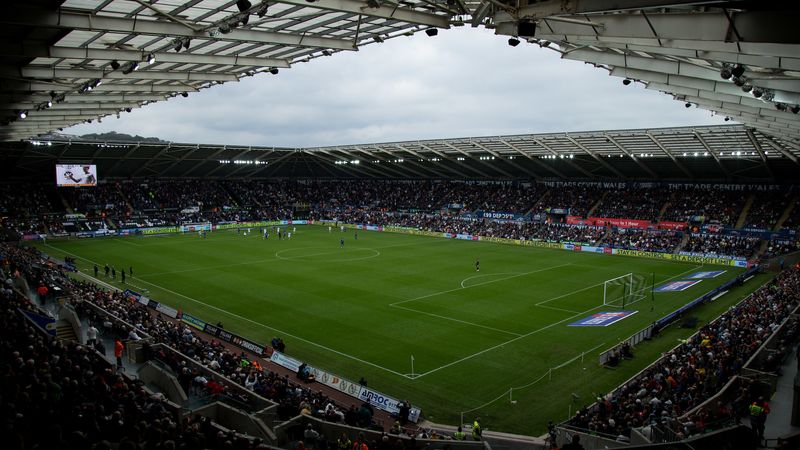
Swansea City spent seven seasons in the Premier League following their promotion in 2011, earning widespread praise for their attractive, possession-based style of football. They secured impressive ninth and eighth-place finishes within their first four campaigns in the top flight.
Their home ground, the Swansea.com Stadium—formerly known as the Liberty Stadium—has a capacity of just over 21,000. It also serves as the home of the Ospreys, a Welsh Rugby Union side competing in the United Rugby Championship since their formation in 2003.
When Swansea reached the Premier League, the stadium became the first in Wales to host top-flight English football. It remains the third-largest stadium in Wales, behind Cardiff City Stadium and the iconic Millennium Stadium.
9. MATRADE Loftus Road Stadium
18,439

The MATRADE Loftus Road Stadium, more commonly referred to as Loftus Road, has been the home of Queens Park Rangers since 1917. QPR were part of the Premier League's early years, spending the first four seasons at Loftus Road and achieving a fifth-place finish in the league's inaugural 1992/93 campaign.
Relegation followed in 1996, and the club didn’t return to the top flight until 2011. However, Premier League football continued at Loftus Road during QPR’s absence, as Fulham temporarily played their home matches there for two seasons while Craven Cottage underwent redevelopment.
QPR’s return to the Premier League in 2011 saw them spend two seasons among England’s elite before another relegation. Their most recent Premier League stint came in 2014/15, but they finished bottom of the table and have remained in the Championship ever since.
8. Baseball Ground
18,300
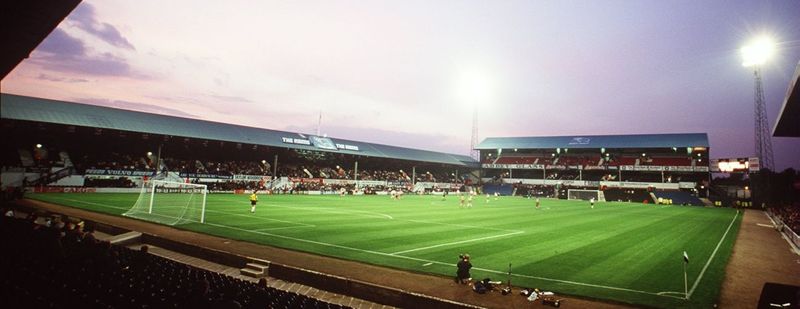
As the name suggests, this stadium was originally built for a different sport. From 1890 to 1898, it served as the home of Derby Baseball Club, but Derby County Football Club became its main tenants in 1895. The Rams earned promotion to the Premier League in 1996 and marked their return to the top flight with a respectable 12th-place finish in their debut season.
The 1996/97 campaign was Derby's final year at the Baseball Ground, with the club set to move into the newly built Pride Park Stadium in the summer of 1997. Arsenal were the visitors on the final day, as fans bid farewell to the historic 18,300-capacity ground. Although Derby's reserve team continued to use the Baseball Ground for several more years, the stadium was ultimately demolished in 2003.
7. Gtech Community Stadium
17,250
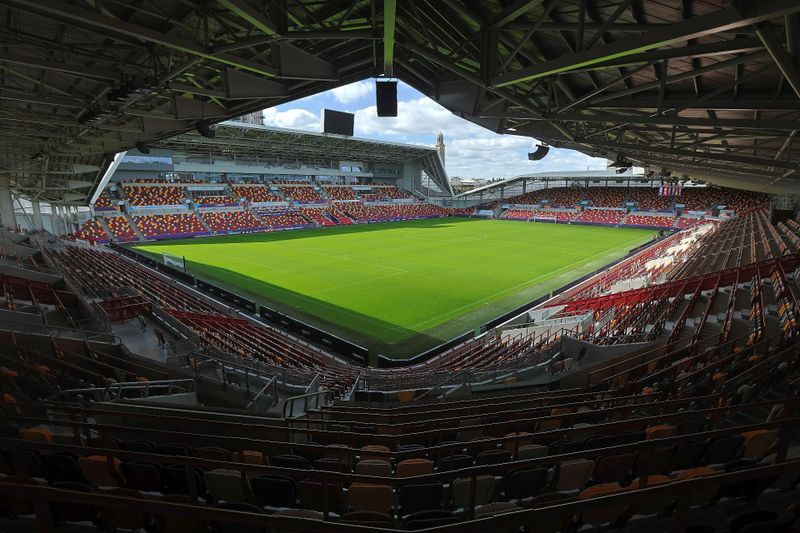
Brentford’s Gtech Community Stadium opened its doors in 2020, and just a year later, the Bees celebrated their historic promotion to the Premier League for the first time. With a capacity of 17,250, it ranks as the second-smallest stadium currently in the English top flight. Nevertheless, Thomas Frank’s side continue to punch above their weight and sat 11th at the halfway mark of the 2024/25 campaign.
In their first three seasons in the Premier League, Brentford secured finishes of 13th, 9th, and 16th — impressive for a club of their size. While the stadium may be modest in comparison to others in the league, it has still played host to major events. Notably, it staged four matches during the UEFA Women’s Euro 2022, including a high-profile quarter-final clash between Germany and Austria, which drew over 16,000 fans.
6. Bloomfield Road
16,220
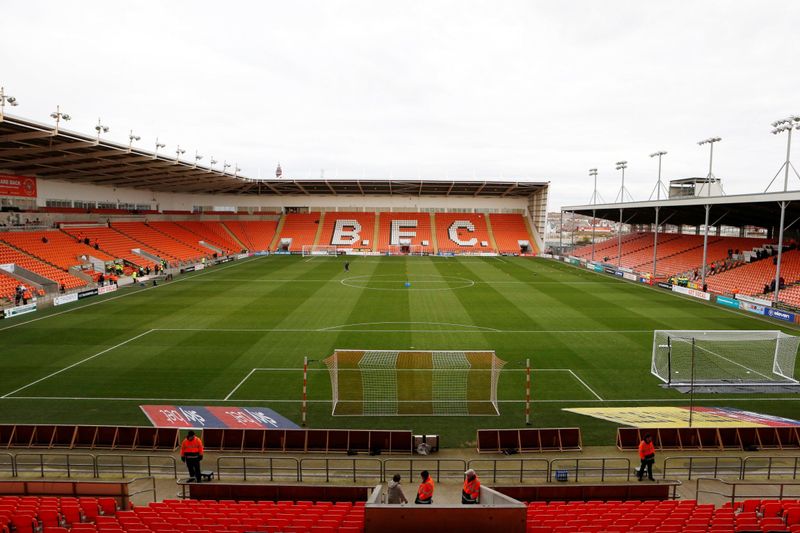
Blackpool enjoyed just a single season in the Premier League under Ian Holloway, earning promotion via the play-offs in 2010. Despite a spirited campaign filled with memorable moments, the Tangerines were relegated back to the Championship on the final day of the 2010/11 season.
Ahead of their top-flight adventure, a temporary stand was constructed on the east side of Bloomfield Road, adding space for just over 5,000 fans. That stand remains in place to this day, with hopes that it will finally be completed and made permanent by 2026.
Since their brief spell among the elite, Blackpool have endured a rollercoaster ride through the leagues. In 2016, they were relegated to League Two during the turbulent tenure of the Oyston family, whose controversial ownership finally ended in 2019. The club earned promotion back to the Championship in 2021 but have since dropped back into League One.
5. County Ground
15,728

Swindon Town’s County Ground has maintained a capacity of 15,728 since the mid-1990s, with plans for redevelopment repeatedly stalled due to the club’s struggles on the pitch. Since being relegated from the Premier League in 1994, Swindon have slipped down the football pyramid and now find themselves battling relegation in League Two.
Historically, the County Ground was owned by Swindon Borough Council, but that changed in March 2023 when the club purchased the stadium for £2.3 million. In a landmark move, supporters secured a 50% stake in the ground, fuelling optimism that long-awaited improvements and redevelopment could finally go ahead now that the club is no longer burdened by rental payments to the council.
4. The Dell
15,200
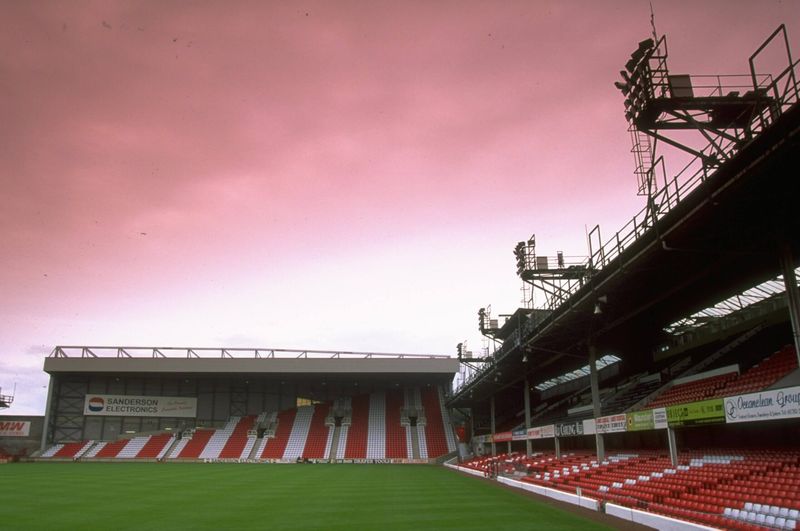
The Dell served as Southampton’s home ground from 1898 until 2001. By the mid-1990s, the club’s board had begun exploring options for a new stadium, with The Dell struggling to meet the demands of a modern Premier League venue. Although the decision to relocate was announced at the end of the 1998/99 season, it wasn’t until 2001 that the move was completed.
During that era, Southampton often flirted with relegation, finishing 18th once and 17th twice in the Premier League. However, they ended their final season at The Dell on a high, securing a 10th-place finish in 2000/01. The ground’s farewell fixture came in the form of a friendly against Brighton & Hove Albion on 26 May 2001, marking the end of an iconic chapter in the club’s history.
3. Boundary Park
13,513
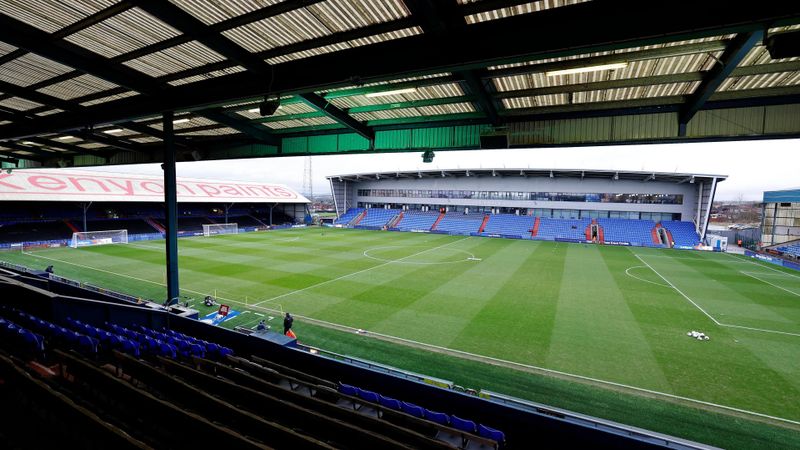
Oldham Athletic enjoyed a brief spell in the Premier League during the early 1990s, spending two seasons in the top flight. At the time, Boundary Park held the distinction of being the smallest stadium in the division during the 1992/93 campaign—a record that stood until AFC Bournemouth’s promotion in 2015.
Prior to their top-flight promotion in 1992, Boundary Park featured an artificial pitch. However, Premier League regulations required natural grass, prompting the club to remove the synthetic surface ahead of the season. Since their relegation from the Premier League, Oldham have experienced a steady decline, suffering multiple demotions and now competing in the National League—the fifth tier of English football.
2. Kenilworth Road
12,056

Luton Town's rise from non-league to the Premier League in just 10 years is nothing short of extraordinary. The Hatters secured their top-flight promotion with a penalty shootout win over Coventry City at Wembley in 2023. To accommodate the necessary ground improvements at Kenilworth Road, Luton played their first two league matches away from home.
The club invested £10 million into upgrading the stadium, including the rebuilding of the Bobbers Stand, which increased the capacity from 10,356 to just over 12,000. Without this expansion, Kenilworth Road would have been the smallest stadium in Premier League history.
Against all odds, Luton fought hard to survive in the Premier League but were ultimately undone by injuries. They finished 18th, six points behind Nottingham Forest, and were relegated back to the Championship.
1. Vitality Stadium
11,307

AFC Bournemouth's Vitality Stadium holds the distinction of being the smallest stadium in Premier League history. After being promoted from the Championship in 2015, the Cherries enjoyed five successful seasons in the top-flight before relegation in 2020. They made their return to the Premier League in 2022 and have since become one of the most well-managed clubs in the division. Under manager Andoni Iraola, Bournemouth finished 12th last season and are currently in the top half, aiming to secure a European spot.
As a result of the club's impressive progress on the pitch, Bournemouth has been exploring the possibility of building a new stadium since 2017. In January 2024, owner Bill Foley revealed plans to construct a new ground "directly behind" the current facility, with an increased capacity of 18,500. The new stadium would feature additional hospitality spaces and more seating on the south side. The club hopes to push forward with these plans in the coming years.

Related Content


























